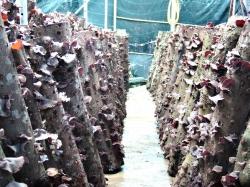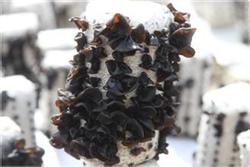High-yield cultivation techniques of Auricularia auricula

The sandy ground or flat grassland with warm climate, small temperature difference between day and night, moist air, sufficient sunshine, close to the water source and not affected by water damage, and the ear field with large cultivation should also take into account the traffic conditions. The land with low-lying terrain and poor drainage should not be used as an ear field. 1.2 after the establishment of the ear field, we should make a good plan to clean, level and disinfect the site according to the amount of earwood. According to our years of research, rack cultivation usually covers an area of 30 square meters and 50 square meters per cubic meter of earwood. 2 preparation of ear wood 2.1 cultivated tree species and wood selection of broad-leaved trees can produce Auricularia auricula under artificial conditions, but some tree species are not suitable to be popularized because of their low economic value. In the eastern part of Liaoning, the commonly used tree species are Ulmus pumila, Juglans mandshurica and Fagaceae oak species. It is proved that the wood whose sapwood thickness is lower than 0.8cm is not suitable to be used as earwood. The diameter class of wood growing on the 6~12cm, the soil is more fertile land wood is an ideal ear wood. 2.2 the cutting time and treatment time of earwood should be in the winter after the land is frozen to before the sap flow. the earwood cut at other times is easy to cause bark shedding and reduce ear production. It is necessary to cut branches in time after cutting. The angle between the cutting section and the radial direction of the tree is 90 °, the wound surface of the otwood should be reduced as much as possible, and the support around the 0.1cm should be retained. The length of the section should be about 1.2cm, and the ear wood should be transported to the ear field in time to dry. (3) Auricularia auricula inoculation is an important procedure in artificial cultivation of Auricularia auricula. The survival rate of inoculation is high, and higher ear production can be obtained without any cost, otherwise it will lead to cultivation failure. 3.1 High-quality strains of Auricularia auricula should be prepared before inoculation is the first condition for high yield of Auricularia auricula. The mycelium should be thick and dense, strong resistance, white up and down, the inner wall of the strain bottle with colorless and transparent water droplets, no shrinkage phenomenon; it is better to smell the fragrance of mushrooms. When the bacteria can not be inoculated immediately after being bought back, the strains should be kept in a cool, clean and odorless environment. The temperature of the storage place should be 3-5 ℃ and the humidity should be 65%-75%. It must not be mixed with chemical fertilizers and pesticides. 3.2 determination of inoculation time according to the conclusion of our experiment, the optimum inoculation time is when the local natural temperature is stable at 5: 8 ℃. Too low or too high temperature has an effect on the survival rate of bacteria. In the eastern part of Liaoning, the best vaccination time is from March 15 to April 5. 3.3 inoculate the bacteria into the wood section nearby. Our common method is to make a hole in the earwood first and put the bacteria into the hole. Seal the hole with a certain material. 3.4.The best burrowing density is 4.2-4.7 × (7-9) cm. Depending on the material of the earwood, the hard one can be denser. The depth of burrowing depends on the hardness of earwood, and the depth of 1.0~1.5cm is more suitable. The depth of auricular point should not exceed the thickness of sapwood, but it should not be shallower than 1.0cm. Too shallow will affect the survival rate due to the small amount of bacteria. 3.6 in order to keep the acupoint clean, it is best to apply bacteria and seal the acupoint and seal the acupoint. When applying bacteria, the strain should be broken into pieces and put into the hole, and the strain should be sent into the hole with the same tool as the diameter of the hole. The strain must be in close contact with the bottom of the ear point to ensure that the strain can make full use of the water in the earwood. The height of the fungus is equal to that of the xylem of the earwood, leaving the bark part of the earwood to seal the hole. There are many materials for sealing holes, such as cork, corncob, paraffin, yellow mud, etc., no matter what materials are used after disinfection. When sealing the hole, it must be sealed flat and strictly sealed. In short, the whole bacterial application process must maintain environmental hygiene, compact procedures, the same day after hitting the hole of the wood section must be finished on the same day, seal the hole. (4) the management technology of ear wood after inoculation the mycelium is mainly restricted by three factors in the whole process of growth and development, namely, temperature, humidity and oxygen. The optimum temperature for mycelium growth of Auricularia auricula was 22-32 ℃. The growth was slow when it was less than 14 ℃, but stopped growing when it was less than 5 ℃, and the mycelium died when it exceeded 36 ℃ for a long time. 4.2 humidity the optimum humidity of Auricularia auricula mycelium is 70%-80%. In the second week after inoculation, the water content of the strain itself can fully meet the needs of mycelium growth, so there is no need to replenish water. At the beginning of the third week, water can evaporate due to changes in environmental conditions, such as temperature rise, wind speed and so on. Water should be replenished every 3 to 5 days, keeping the water content of the earwood above 35%, and keeping the bark on the surface of the earwood free of water marks to prevent the breeding of miscellaneous bacteria. 4.3 Auricularia auricula is an aerobic fungus, which needs to absorb a lot of oxygen in its life activities. 10 days after inoculation, the auricula can often be overturned according to the changes of environmental conditions until the fruiting body is seen on the auricula. Taking the stacking bacteria as an example, when the surface temperature of the stack is 20 ℃, the temperature of the lower layer of the stack is only about ℃. However, the humidity of the bottom layer of the stack is much higher than that of the surface layer, so it should be combined with rehydration and stacking once every 7-10 days, which can not only ensure the need for oxygen, but also adjust the temperature and humidity between the earwood. (5) the management of ear production period mycelium developed to a certain extent, accumulated a lot of nutrition in the body, and then changed from the vegetative growth stage to the reproductive growth stage. At this stage of management, temperature is no longer the main factor, while humidity and oxygen are very important factors. 5.1 in the early stage, when about 30% of the ear buds appeared on the ear wood, the ear wood should be transferred to the ear site, at this time, the nutrient accumulation of the mycelium in the ear wood was not very sufficient, so it could not replenish water frequently to prevent the phenomenon of excessive water content and poor ventilation (if so, it will produce a large number of flowing ears). Normal management method: depending on the weather, watering once every 5-7 days (that is, the earwood is fully hydrated), gradually reduced to 1. 5% every 1-2 days. Permeate every time, and finally reach watering once a day. Watering should be carried out every evening. In addition, but also often to the earwood to turn around, turn around, in order to adjust the temperature and humidity in the earwood. 5.2 after each ear harvest in the middle and later stage, the mycelium was in a state of nutrient deficiency and weakness. The water content in the earwood has been saturated, and the ventilation of the earwood is very poor, so the earwood should be dried in time. The drying time can be determined according to the water content of the earwood, usually 10 to 20 days. When the water content of ear wood is reduced to about 35%, the watering process can be restored to the previous management, and the production of the next stubble ear can be carried out. 5.3 picking of Auricularia auricula when wrinkles appear on the edge of the fruiting body of Auricularia auricula, ear stalks contract, and a large amount of white spore powder appears in the abdomen of the ear piece, it indicates that the ear piece is mature and should be harvested in time. Water should be stopped in the sun section before harvest, so that the fungus should be dried on the wood and then harvested (try not to pick fresh ears). The harvest of spring ear and autumn ear can be big and small, and the ear should be harvested together.
- Prev

Identification technique of Auricularia auricula strain
1, the mycelium is white, like fine wool, the hair is short and neat, dense, strong and powerful, extending side by side to the bottom of the bottle, growing evenly, consistent up and down, dug out into blocks, not loose. 2. After the mycelium grows full, brown water droplets are generally secreted on the surface of the bacteria. After that, light yellow appeared around the bottle wall and on the surface.
- Next

High-yield techniques of bag cultivation of Auricularia auricula
In recent years, substitute cultivation of Auricularia auricula has become one of the ways for northern farmers to shake off poverty and become rich. Farmers in Yushu County, using sawdust, corncob and other agricultural by-product resources, planted 800000 bags of Auricularia auricula in bags and mined about 60 days after inoculation. each bag could collect 30 grams of dried fungus and 28000 kg of Auricularia auricula that year with an income of 120.
Related
- Fuxing push coffee new agricultural production and marketing class: lack of small-scale processing plants
- Jujube rice field leisure farm deep ploughing Yilan for five years to create a space for organic food and play
- Nongyu Farm-A trial of organic papaya for brave women with advanced technology
- Four points for attention in the prevention and control of diseases and insect pests of edible fungi
- How to add nutrient solution to Edible Fungi
- Is there any good way to control edible fungus mites?
- Open Inoculation Technology of Edible Fungi
- Is there any clever way to use fertilizer for edible fungus in winter?
- What agents are used to kill the pathogens of edible fungi in the mushroom shed?
- Rapid drying of Edible Fungi

